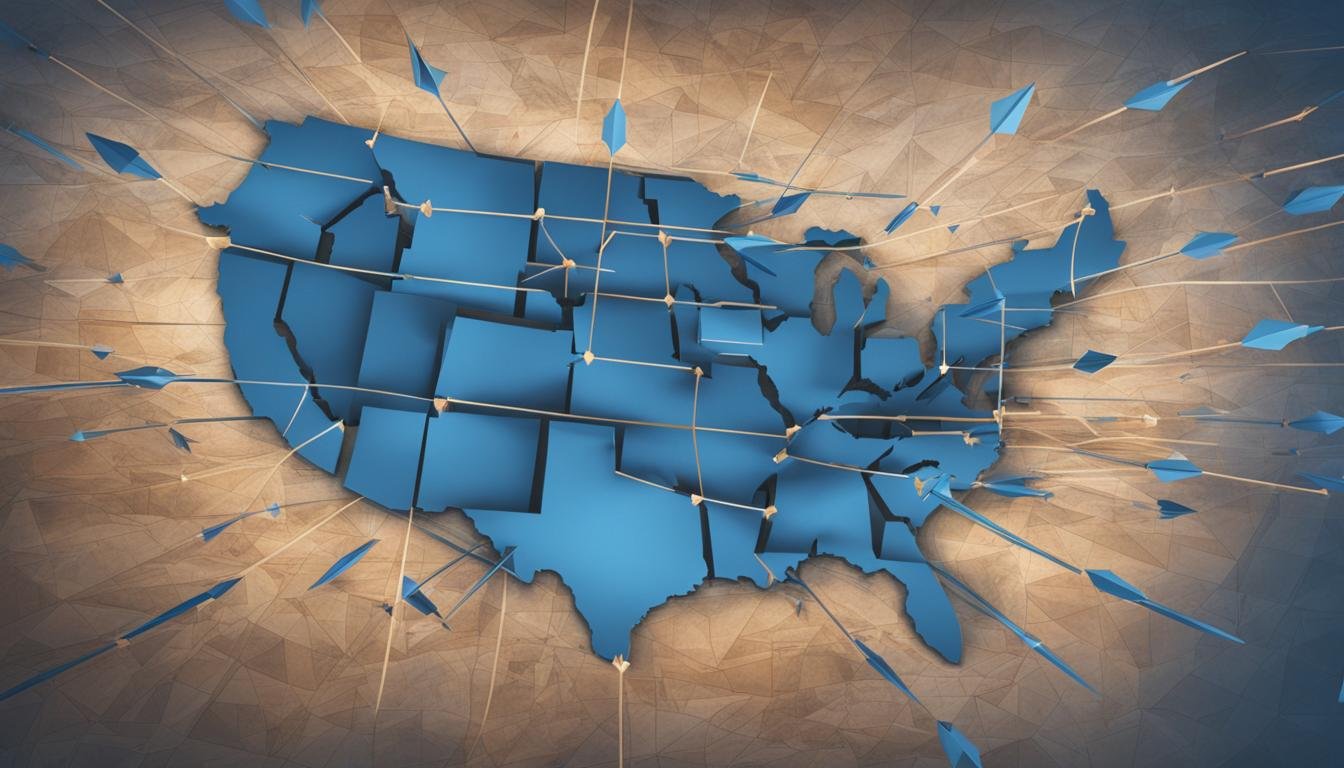Are you struggling to repay your student loans? Do you worry about the ever-increasing student loan debt and the impact it will have on your financial future? If so, you are not alone. The good news is that there are student loan forgiveness programs available to help alleviate your financial burden and provide long-term financial stability.
At our platform, we are dedicated to helping you explore the top-rated student loan forgiveness programs available in the United States. With our guidance, you can find the perfect program to make your post-graduation journey smoother and financially stress-free.
Key Takeaways
- Student loan forgiveness programs can provide a financial lifeline to those struggling with student loan debt.
- Our platform offers guidance and resources to help you explore the best student loan forgiveness programs available.
- Understanding the qualifications and requirements of different student loan forgiveness programs is key to finding the right fit for your individual circumstances.
- Programs such as Public Service Loan Forgiveness and Nurse Loan Forgiveness are tailored to specific professions.
- By participating in a student loan forgiveness program, you can achieve long-term financial stability and improve your credit score.
Understanding Student Loan Forgiveness Options
If you’re struggling with student loan debt, exploring your forgiveness options is one way to lighten the financial burden. The good news is that there are several student loan forgiveness options available to borrowers.
First, it’s important to understand the key differences between federal and private forgiveness programs. Federal programs are typically more flexible, with a wider range of forgiveness options and more lenient eligibility requirements. Private programs, on the other hand, are generally more restrictive and may only be available to borrowers with specific types of loans or income levels.
Federal Forgiveness Programs
There are several types of federal forgiveness programs available, including:
| Program Name | Description |
|---|---|
| Public Service Loan Forgiveness (PSLF) | Forgives the remaining balance on Direct Loans after making 120 qualifying monthly payments while working full-time for a qualifying employer. |
| Teacher Loan Forgiveness | Forgives up to $17,500 in Direct or FFEL Subsidized or Unsubsidized Loans and Subsidized or Unsubsidized Federal Stafford Loans for teachers who work full-time in a low-income school or educational service agency for five consecutive years. |
| Perkins Loan Cancellation and Discharge | Forgives up to 100% of Federal Perkins Loans for teachers, nurses, law enforcement officers, and other public servants who meet specific eligibility requirements. |
It’s important to note that each program has its own eligibility requirements and forgiveness criteria. Some programs may also require you to work in a specific field or location for a certain amount of time before you can qualify for forgiveness.
Private Forgiveness Programs
Private forgiveness programs are typically offered by individual lenders or loan servicers. These programs may offer forgiveness based on factors like income, employment status, or other eligibility criteria. In some cases, private lenders may also offer loan modification or consolidation programs as a form of debt relief.
However, it’s important to do your research and carefully review the terms and conditions of any private forgiveness program before signing up. Some programs may come with hidden fees or other unexpected costs, and may not offer the same level of protection as federal programs.
Ultimately, the best forgiveness option for you will depend on your individual circumstances and financial goals. By exploring your options and working with a trusted financial advisor, you can find the program that’s right for you and start on the path to financial freedom.
Qualifications for Student Loan Forgiveness Programs
At the heart of student loan forgiveness programs are specific qualifications that borrowers must meet to be eligible. These qualifications vary depending on the type of program and can include everything from the borrower’s employment status to their chosen profession.
Income Thresholds
Many student loan forgiveness programs require borrowers to meet certain income thresholds. For example, the Public Service Loan Forgiveness program requires borrowers to have a qualifying job and make 120 qualifying payments while working full-time for a qualifying employer.
These payments must be made on specific repayment plans that are designed to make loan forgiveness accessible to a wide range of borrowers, regardless of their income levels.
Employment Requirements
Student loan forgiveness programs often have specific employment requirements that borrowers must meet to be eligible. For example, the Teacher Loan Forgiveness program requires borrowers to be employed full-time at a qualifying school or educational service agency.
Similarly, the Public Service Loan Forgiveness program requires borrowers to work full-time for a qualifying employer, such as a government or nonprofit organization.
Specific Eligibility Criteria
Some student loan forgiveness programs have specific eligibility criteria that must be met before borrowers can participate. For example, the Nurse Corps Loan Repayment Program requires borrowers to be licensed registered nurses, advanced practice registered nurses, or nurse faculty members.
Additionally, borrowers must be employed full-time in a critical shortage facility or accredited school of nursing to be eligible.
Conclusion
Understanding the qualifications for student loan forgiveness programs is crucial for borrowers who want to take advantage of these programs. By meeting the necessary criteria, borrowers can gain access to financial relief and long-term stability. Let us help you explore your options and determine which program is the right fit for you.
Federal Student Loan Forgiveness Programs
If you have federal student loans, you may be eligible for loan forgiveness through one of several government programs. Here, we’ll explore the most popular federal programs and their requirements.
Public Service Loan Forgiveness (PSLF)
The PSLF program forgives the remaining balance of your Direct Loans after you have made 120 qualifying payments while working full-time for a qualifying employer, such as a nonprofit organization or government agency. The 120 payments do not have to be consecutive, and you must be enrolled in an eligible repayment plan.
To qualify for PSLF, you must:
- Have Direct Loans
- Work full-time for a qualifying employer
- Make 120 qualifying payments on an eligible repayment plan
- Be in good standing on your loans at the time of forgiveness
It’s important to note that not all employers qualify for PSLF, and you should submit an Employment Certification Form to ensure your employer and payments are eligible.
Teacher Loan Forgiveness
The Teacher Loan Forgiveness program forgives up to $17,500 of your Direct or Stafford Loans if you teach full-time for five consecutive years at a low-income school or educational service agency. You must have no outstanding balance on your loans at the end of the five-year period.
To qualify for Teacher Loan Forgiveness, you must:
- Be a highly qualified teacher
- Teach full-time for five consecutive years in a low-income school or educational service agency
- Have Direct or Stafford Loans
It’s important to note that you cannot receive both PSLF and Teacher Loan Forgiveness for the same period of teaching.
Other Forgiveness Programs
In addition to PSLF and Teacher Loan Forgiveness, there are other federal loan forgiveness programs available, such as:
- Income-Driven Repayment Plans: after making payments for 20 to 25 years on an eligible plan, the remaining balance may be forgiven
- Disability Discharge: for borrowers who are unable to work due to a disability
- Death Discharge: for the borrower’s loans to be discharged in the event of their death
It’s important to review the eligibility requirements and conditions of each program to determine if it’s the right option for you.
Explore Specific Loan Forgiveness Programs
Not all loan forgiveness programs are created equal, and some are tailored to specific professions. Let’s take a closer look at some of the most popular programs available.
Public Service Loan Forgiveness
If you work in a public service role, such as for a government organization or non-profit, you may be eligible for Public Service Loan Forgiveness (PSLF). This program forgives your remaining federal student loan balance after you make 120 qualifying monthly payments while working full time in a qualifying public service job. The forgiven amount is tax-free, and there is no limit to the amount that can be forgiven. To be eligible, you must have Direct Loans and be enrolled in an income-driven repayment plan.
Teacher Loan Forgiveness
Teachers who work full-time for five consecutive school years in low-income schools or educational service agencies may qualify for Teacher Loan Forgiveness. This program forgives up to $17,500 of your direct or FFEL subsidized or unsubsidized loans. To be eligible, teachers must not have an outstanding balance on their loans as of October 1, 1998, and must have served five full academic years in a qualifying school.
Nurse Loan Forgiveness
If you are a nurse working in a critical shortage area, you may be eligible for Nurse Loan Forgiveness. This program forgives up to 85% of your unpaid nursing student loan balance after two years of employment in a critical shortage area. You may also qualify for loan repayment assistance through your employer or the National Health Service Corps.
| Public Service Loan Forgiveness | Teacher Loan Forgiveness | Nurse Loan Forgiveness | |
|---|---|---|---|
| Eligibility | Full-time work in qualifying public service job. Direct Loans, enrolled in income-driven repayment plan. | Five consecutive years of full-time work in low-income school or educational service agency. | Two years of work in a critical shortage area as a nurse. |
| Forgiven Amount | Remaining balance after 120 qualifying payments. | Up to $17,500 of direct or FFEL loans. | Up to 85% of unpaid nursing student loan balance. |
| Taxable? | No | No | Yes |
These programs offer valuable assistance to borrowers working in specific fields, providing a path to financial freedom while rewarding public service and commitment. Explore the programs to determine if they are a good fit for your circumstances and career goals.
Benefits of Student Loan Forgiveness
Participating in a student loan forgiveness program has many benefits that can positively impact your financial future. Here are some of the key benefits:
- Reduced Financial Burden: One of the most significant benefits of student loan forgiveness is the reduction of financial burden. By participating in a forgiveness program, you can potentially have a portion, if not all, of your outstanding student loan debt forgiven.
- Improved Credit Scores: Defaulting on your student loans can have a negative impact on your credit score. By participating in a forgiveness program and staying on top of your payments, you can improve your credit score and increase your chances of being approved for future loans or credit.
- Long-Term Financial Stability: By having your student loans forgiven, you can achieve long-term financial stability. With the burden of student loans lifted, you can use the extra money to save for retirement, purchase a home, or invest in your future.
It’s essential to understand the benefits of student loan forgiveness programs and how they can positively impact your financial future. Our team can help you navigate the different programs available and determine which one is the best fit for your specific situation.
Requirements for Student Loan Forgiveness
To qualify for student loan forgiveness programs, you must meet specific requirements. Understanding these requirements is essential to determine which programs are the best fit for your circumstances. Below are some of the critical student loan forgiveness requirements:
- Loan Type: Only certain types of loans are eligible for forgiveness programs. Loan types such as Direct Loans, Perkins Loans, and FFEL Loans are the usual candidates for loan forgiveness programs.
- Repayment Plan: Loan repayment plans are another critical factor in determining eligibility for loan forgiveness. Generally, borrowers must be enrolled in specific repayment plans such as Income-Driven Repayment (IDR) or Pay As You Earn (PAYE).
- Employment: Some loan forgiveness programs require working in specific industries or professions for a specific period. For instance, public service jobs usually require ten years of employment to qualify for the Public Service Loan Forgiveness program.
- On-Time Payments: Making on-time payments is an essential requirement for qualifying for loan forgiveness programs. Delinquent or missed payments may disqualify you from receiving loan forgiveness.
- Loan Balance: Some loan forgiveness programs have specific loan balance requirements. For instance, the Teacher Loan Forgiveness program forgives up to $17,500 in loans for teachers who work for five consecutive years in a low-income school.
Meeting these requirements is the first step towards receiving loan forgiveness. However, it’s essential to note that each program may have additional criteria. Therefore, it’s vital to review each program’s conditions carefully to ensure you meet all requirements.
Checking Eligibility for Student Loan Forgiveness
If you are struggling with student loan debt, you may be wondering if you qualify for student loan forgiveness. Fortunately, there are multiple programs available, each with its own set of qualifications.
The first step in determining your eligibility for student loan forgiveness is to identify the programs you may be eligible for based on your profession, income, and other factors. Programs such as Public Service Loan Forgiveness, Teacher Loan Forgiveness, and Nurse Loan Forgiveness have specific eligibility requirements that you must meet.
Determining Eligibility for Public Service Loan Forgiveness
Public Service Loan Forgiveness is available to individuals who work in public service jobs, such as government or non-profit organizations. To be eligible, you must have eligible federal student loans, be enrolled in an income-driven repayment plan, and make 120 qualifying payments. Qualifying payments are payments made on time, in full, and while you are employed full-time by a qualifying employer.
Determining Eligibility for Teacher Loan Forgiveness
Teacher Loan Forgiveness is available to teachers who have been employed full-time for five consecutive years at a qualifying low-income school or educational service agency. To be eligible, you must have eligible federal student loans and not be in default. The forgiveness amount varies based on the subject taught and the level of education.
Determining Eligibility for Nurse Loan Forgiveness
Nurse Loan Forgiveness is available to registered nurses and nurse practitioners who work full-time at a qualifying healthcare facility. To be eligible, you must have eligible federal student loans and work in a critical shortage area or at an eligible facility. The forgiveness amount varies based on the length of service and the level of education.
It’s important to note that even if you meet the eligibility requirements for a specific program, you must still apply and be approved for forgiveness. Additionally, it’s important to keep track of any requirements or changes to program eligibility criteria.
If you’re unsure about your eligibility for student loan forgiveness, there are resources available to help. You can start by visiting the Federal Student Aid website or speaking with a financial advisor.
Conclusion
As your trusted source for student loan forgiveness programs, we hope that this article has provided you with valuable information to make informed decisions about your post-graduation journey. We strongly believe that exploring the options available to you is essential in managing your financial future, and we are committed to helping you achieve success.
By understanding the various student loan forgiveness programs, you can select the best program that fits your individual circumstances and qualifications. These programs offer numerous benefits such as reducing financial burden, improving credit scores, and providing long-term financial stability.
Take Action Today
To take advantage of the student loan forgiveness programs available to you, it is important to stay informed about the qualifications, requirements, and application process. You can use our comprehensive resources to check your eligibility and apply for programs such as Public Service Loan Forgiveness, Teacher Loan Forgiveness, and Nurse Loan Forgiveness.
We are here to support you every step of the way, and we encourage you to reach out to us with any questions or concerns. Let us help you make the most of your post-graduation journey and achieve financial freedom.
Thank you for choosing us as your partner in navigating the world of student loan forgiveness programs.
FAQ
What are the top-rated student loan forgiveness programs?
The top-rated student loan forgiveness programs include Public Service Loan Forgiveness (PSLF), Teacher Loan Forgiveness, and Nurse Loan Forgiveness, among others.
What are the different student loan forgiveness options?
The different student loan forgiveness options include federal forgiveness programs and private forgiveness programs. Federal forgiveness programs are offered by the government, while private forgiveness programs are offered by specific institutions or organizations.
What qualifications do I need for student loan forgiveness programs?
The qualifications for student loan forgiveness programs vary depending on the program. Generally, criteria such as income thresholds, employment requirements, and specific eligibility criteria for different professions are taken into consideration.
What are some federal student loan forgiveness programs?
Some federal student loan forgiveness programs include Public Service Loan Forgiveness (PSLF), Teacher Loan Forgiveness, and Military Loan Forgiveness, among others.
Are there specific loan forgiveness programs for certain professions?
Yes, there are specific loan forgiveness programs tailored to different professions. For example, there is Public Service Loan Forgiveness for public servants, Teacher Loan Forgiveness for educators, and Nurse Loan Forgiveness for healthcare professionals, among others.
What are the benefits of student loan forgiveness?
Participating in a student loan forgiveness program can alleviate financial burden, improve credit scores, and provide long-term financial stability. It can also help borrowers achieve debt freedom faster.
What are the requirements for student loan forgiveness?
The requirements for student loan forgiveness programs may include having specific types of loans, being on certain repayment plans, meeting employment or service requirements, and fulfilling certain timelines for program participation.
How can I check my eligibility for student loan forgiveness?
To check your eligibility for student loan forgiveness programs, you can review the specific requirements outlined by the program you are interested in. Resources and step-by-step instructions are available to help you determine if you meet the necessary criteria.








